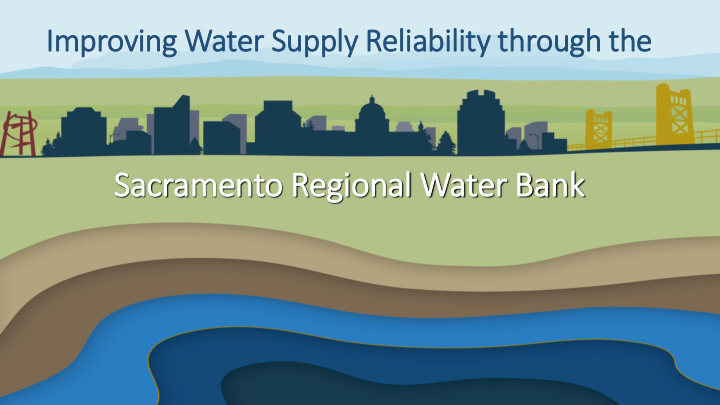



Im Improving Water Supply Reliability through the Sacramento Regional Water Bank
The region has already seen success from conjunctive use North American Subbasin South American Subbasin
Despite this success, we can’t ignore longer -term changes in hydrology Folsom Lake Storage Levels 1,000,000 Total Reservoir Capacity: 977,000 acre-feet 950,000 900,000 850,000 800,000 Folsom Lake Reservoir Level (acre-feet) 750,000 700,000 650,000 600,000 550,000 500,000 In fact, SGMA compels us to 450,000 400,000 350,000 take the long view 300,000 250,000 200,000 150,000 100,000 Oct 1 Nov 1 Dec 1 Jan 1 Feb 1 Mar 1 Apr 1 May 1 Jun 1 Jul 1 Aug 1 Sep 1 Water Year (WY) (October 1 - September 30) Historical Average Recent Average (WY 2001 - Current)
It seems that we have plenty of conjunctive use potential 20,000 18,000 16,000 14,000 12,000 10,000 8,000 6,000 4,000 2,000 0 Jan Feb Mar Apr May Jun Jul Aug Sep Oct Nov Dec Still have plenty of existing In excess of 1.8 million AF groundwater use to offset available storage space
Conjunctive use analysis was performed for agencies overlying the groundwater basin and contiguous with each other Two fundamental questions 1. What we can do today by reoperating existing system? Area 1 2. What we can do over next 10 years with new facilities added to system? Area 2 Constraints Considered: Area 3 • Whether or not systems fluoridate • Water rights/contracts • Surface water treatment plant capacity • Conveyance/intertie capacity • Groundwater production capacity Area 4 • Operational issues identified by purveyors Constraint Not Considered: • Cost of water
Recharge Potential Recovery Potential Actual Actual (2015) (2011-13 Average) 36% 31% Potential Potential (2015) 64% 69% (2011-13 Average) 14% Surface Water Surface Water 42% Groundwater Groundwater 58% 86% Surface Water Surface Water Groundwater Groundwater
We have conjunctive use potential, but we still lack incentive to act further Opportunities Barriers • For existing system, reoperations cost differential is in excess of With Near- $300 per acre-foot Term New Facilities • For new facilities, capital costs estimated at about $288 million With Existing System (Wet Year) (Dry Year)
Developing a Water Bank can help incentivize expanding conjunctive use and ensure future sustainability • Single year transfers (“spot market”) by • Multi- year storage (“long - term market”) of using groundwater in place of an existing Central Valley Project contract water for internal surface water right or external partners • Storage before recovery not required • Storage before recovery • One-time loss factor at time of transfer • Loss factor over length of storage • Monitoring and mitigation • Monitoring and mitigation
Following groundwater banking guidelines can help ensure success under SGMA
A 2018 pilot proved our ability to work together and understand many of the mechanisms of a Water Bank 10 MW - Chuckwagon 5 0 -5 -10 -15 Transfer Period -20 -25 -30 -35 -40 60 Production Wells Sep-17 Nov-17 Jan-18 Mar-18 May-18 Jul-18 Sep-18 Nov-18 Jan-19 Mar-19 May-19 Jul-19 Sep-19 Nov-19 20 Monitoring Wells
The 2018 pilot showed the positive results of agencies working together July through September Totals in Acre-feet Agency Baseline Total Pumped Transfer Credited* Groundwater Use City of Sacramento 2,426 4,491 2,313 SSWD 3,074 8,077 4,602 CWD 1,001 1,390 358 CHWD 130 1,584 1,338 FOWD 393 1,989 1,469 Totals 7,024 17,981 10,080 *Includes 8% streamflow depletion
The path to the Water Bank and its expansion Finish planning to • 2022 • ~ $2 million become fully operational Build additional • ~2030 • ~$288 million facilities to expand • Expansion scalable as funds available on operations
A Water Bank can start small and grow substantially North American through time Subbasin Sources of recharge Municipal in-lieu Municipal direct T i Recycled in-lieu m Flood-MAR e South American Agricultural in-lieu Subbasin
Recommend
More recommend